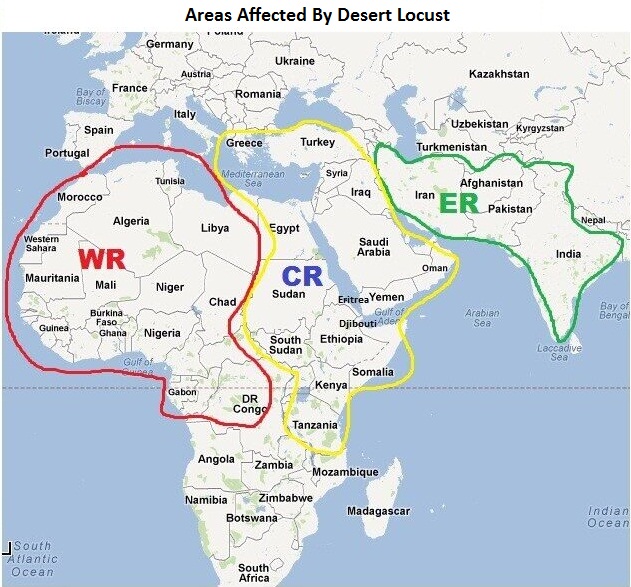Biodiversity & Environment
Swarm of Desert Locust
- 02 Jun 2020
- 8 min read
This article is based on “Why is the locust surge posing a threat to agriculture in India” which was published in the Hindu on 31/05/2020. It talks about the impact of swarms of desert locust on agriculture and its linkage with climate change.
While India is grappling with several disasters like Covid-19 pandemic, Cyclone Amphan, Vizag Styrene gas leak disaster and others, the Locust Warning Organization has warned of one of the worst desert locust attacks in decades.
Swarms of desert locusts entered western India from Pakistan and destroyed crops in many states such as Rajasthan, Uttar Pradesh (UP), Madhya Pradesh.
India has not witnessed full-blown locust cycles since 1993. Heavy rains and an increasing number of cyclones, both are a result of the climate crisis, enabled unprecedented breeding and the rapid growth of locust populations on the Arabian Peninsula, last year.
The high magnitude of insects attack and their early arrival highlights a critical aspect of global warming i.e. it may link disparate disasters — floods, pandemics and pestilence — amplifying the potency of each.
Thus, to deal with natural disasters like locust attacks, there is a need to develop an integrated framework of climate change mitigation, disaster management and sustainable development.
Note:
- Due to the 1926-1932 locust plague in India, the British government began research into the desert locust.
- It then led to the establishment, in 1939, of a permanent Locust Warning Organization (LWO), with a station in Karachi (undivided India).
- Its main job was to keep out an eye for a specific sub-species of the insect, the desert locust, that sprang into the region from the Thar desert.
- After independence, India established its own centre at Jodhpur, Rajasthan, as a part of the Directorate of Plant Protection Quarantine and Storage, under the Ministry of Agriculture.
Climate Change and Swarm of Locust
- There are two meteorological drivers behind the current locust attack in India:
- One, unseasonal heavy rains in the main spring-breeding tracts in Arabian peninsula in March-April.
- Two, strong westerly winds from the Arabian peninsula to India.
- According to meteorologists, a differential pattern of warming in the Indian Ocean (Indian-ocean dipole) may be a trigger.
- Last year saw one of the strongest positive dipoles in the Indian neighbourhood which brought on a difference of more than two degrees in temperature of the western and eastern Indian ocean.
- Due to climate change, the anomalies in the Indian ocean dipole are increasing and subsequently, the monsoon pattern, intensity, cyclonic storms, are undergoing change.
- The locust attack is just a manifestation of this change.
- Due to this, in 2019, the monsoon started six weeks ahead of time in western India. It also lasted till November, instead of the usual September/October cycle.
- The extended rains created breeding conditions and also produced natural vegetation on which locusts feed.
- Further, cyclonic storms Mekunu and Luban struck Oman and Yemen respectively in the last year. Heavy rains had transformed uninhabited desert tracts into the large lake where the locust swarms breed.
- Locusts are known to be passive flyers and generally follow the wind. Their movement has been aided by westerly winds, which further strengthened by the low-pressure area created by Cyclone Amphan in the Bay of Bengal.
Indian Ocean Dipole
- A phenomenon called the Indian Ocean Dipole, in which the western and eastern parts of the ocean, warm differentially, tend to have an outsized impact in bringing excessive rains to India and West Asia.
- A ‘positive’ dipole is when the western part is hotter by a degree or more than the eastern.
- A negative dipole phase would bring about the opposite conditions - warmer water and greater precipitation in the eastern Indian Ocean, and cooler and drier conditions in the west.
Impact of Locust Attack
- Affecting Food Security: If their breeding is coterminous with that of the Kharif crop, then it could well have a detrimental effect on rice, maize and sorghum.
- The Food and Agriculture Organization has warned that the locust attack could lead to a major threat to food security.
- Affecting Farmers: This means that locusts not only devour valuable standing crops but can also devastate livelihoods of farmers and those associated with the agricultural supply chain.
- Affecting Urban Areas: Due to the recent harvest of Rabi crops, there were no crops in the field, the desert locusts have been invading green spaces in urban areas
- Though locusts are unlikely to be a major threat in urban centres, still they can disrupt day-to-day life.
- Moreover, the effects of locust in urban areas may aggravate, as the national lockdown has made the availability and transportation of pesticide and labour difficult.
Way Forward
- Immediate Measure: A proactive control of locust attack through aerial spraying of the optimum quantity of insecticides in all potential breeding sites, is required, along with continuous monitoring of the crops during the ensuing Kharif season.
- Need for Systemic Study on locust: Indian Council of Agricultural Research (ICAR) admitted that there hasn’t been much “systematic research” on desert locusts since the 1990s and the current invasion is a wake-up call to revive the programme.
- Strengthening Research Framework for Climate Change: Due to the emergence of new dimensions of climate change, it is important that India puts in more funds to predict the course of the present global environmental changes to understand the sources, consequences, and formulate national responses.
- Strengthening Decentralisation: There is a need to strengthen disaster management framework at the local level as highlighted by the Fourteenth Finance Commission report and Disaster Management Act, 2005.
- Regional Cooperation: There is a need for collective regional efforts, as these locusts usually breed in the dry areas of Eastern Africa (especially Horn Of Africa) and the Arabian peninsula and enter finally to India.
|
Drishti Mains Question Discuss the impact of swarms of desert locust on agriculture and its linkages with climate change. |
This editorial is based on “Land of the unfree: On U.S. unrest” which was published on The Hindu on June 1st, 2020. Now watch this on our Youtube channel.






